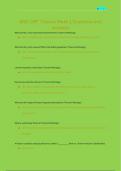1|P a g e
MSC ORT Trauma Week 5 Questions and
Answers
What are the 4 most commonly fractured bones? (Trauma Pathology)
o :## Vertebral body, Distal Radius, Proximal Femur (Hip), Tibia/Fibula (Ankle)
What are the 3 main causes of falls in the elderly population? (Trauma Pathology)
o :## Chronic health conditions (heart disease), Dementia, Low blood pressure
(hypotension)
List the long bones in the body. (Trauma Pathology)
o :## Humerus, Radius, Ulna, Femur, Tibia, Fibula
How do you describe a fracture? (Trauma Pathology)
o :## Bone location, joint involvement, fracture fragments, displacement,
angulation, open vs. closed, other qualities
What are the 6 types of fracture fragment descriptions? (Trauma Pathology)
o :## Transverse, linear, oblique non displaced, oblique displaced, spiral, greenstick,
comminuted
What is a pathologic fracture? (Trauma Pathology)
o :## Something caused from an underlying disease, often time presence of lesion in
the bone
A fracture caused by torquing the bone is called a __________ fracture. (Trauma Fracture Classification)
o :## Spiral
, 2|P a g e
If a bone has a butterfly fracture it can also be called by another name, which means the same thing. It
can be described as fitting in a group of fractures which are called __________ fractures collectively.
(Trauma Fracture Classification)
o :## Comminuted
Describe a Colles fracture. (Trauma Fracture Classification)
o :## Dorsal fracture of the distal radius
What are the most common fracture classifications in orthopaedics? (Trauma Fracture Classification)
o :## AO/OTA, Gardener, Schatzker, Neer, Weber, Distal Radius Fx, Tscherne
What type of diagnostic imaging can be used to diagnose a fracture? (Trauma Fracture Classification)
o :## X-Ray
Describe how to read an x-ray. (Trauma Fracture Classification)
o :## An x-ray examination creates images of your internal organs or bones to help
diagnose conditions or injuries.
What is compartment syndrome? (Trauma Fracture Classification)
o :## Pressurized fluid in a portion of a limb
How were fractures traditionally treated before internal fixation was introduced? (Trauma Early
Treatment)
o :## Immobilization, traction, and amputation
What types of metal are K-wires, plates, and screws used in internal fixation made of? (Trauma Early
Treatment)
o :## Titanium, stainless steel
What are some reasons hardware is removed? (Trauma Early Treatment)
, 3|P a g e
o :## Infection, patient discomfort, hardware breakage, suspected allergic reaction
What are the 2 main thread types for screws? (Trauma Early Treatment)
o :## Cortical screws and cancellous screws
What is the difference between a cortical and cancellous screw? (Trauma Early Treatment)
o :## Cortical screw: smaller thread pitch, smaller thread height; stronger b/c of the
bigger core, usually blunt tip, usually inserted bi-cortically for maximum fixation, tip
should only extend 1-2 mm beyond the cortex. Cancellous screw: bigger thread
pitch, bigger thread height; used in metaphysis of larger bones, usually not bi-
cortical, partially threaded screws used as lag screws, pre-drill near cortex needed
b/c of less dense bone type
What are the functions of a screw? (Trauma Early Treatment)
o :## Fix fragments in place, compress two bone fragments together, anchor a wire
or instrument, attach plate to the bone
What are the 5 key functions of plates? (Trauma Plates and Screws)
o :## Neutralization, buttress (anti-glide), bridging, tension band, compression
Explain how a buttress plate functions and what type of healing occurs (Trauma Plates and Screws)
o :## Providing support in one direction. Anti-glide. Usually around a joint
What does LC-DCP stand for and why is it important? (Trauma Plates and Screws)
o :## Limited contact direct compression plate. It has a scalloped undersurface to
limit bone contact which improves blood circulation
Explain how locked plating works. (Trauma Plates and Screws)




